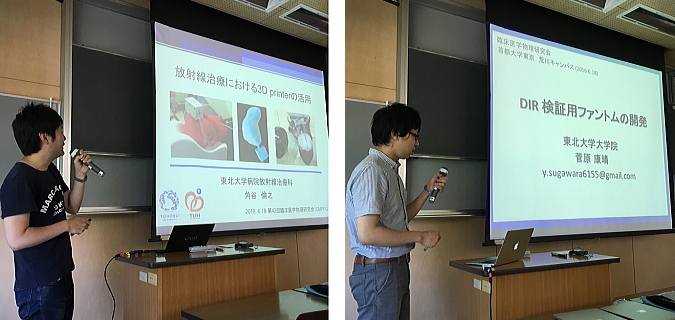2016.6.18:CMPFG42th regular meeting
Dr. Kadoya(Assistant professor), Mr. Sugawara(D3), Mr. Katsuta(D2) and Mr. Nakajima(D1) have attended 42th CMPFG regular meeting for presentation. Mr. Takayama(M2), Mr. Miyasaka(M2), Mr. Abe(M1), Mr. Ieko(M1), Mr. Ikeda(M1) and Mr. Kon(M1) have attended it in Tokyo Metropolitan University, Tokyo, Japan on June 18, 2016.
■Date: June 18, 2016
■Venue: Tokyo Metropolitan University, Tokyo, Japan
■Conference name:42Th CMPFG regular meeting

Kota Abe(M1)
Dr. Kadoya(Assistant professor), Mr. Sugawara(D3), Mr. Katsuta(D2) and Mr. Nakajima(D1) have attended 42th CMPFG regular meeting as lectures. Mr. Takayama(M2), Mr. Miyasaka(M2), Mr. Abe(M1), Mr. Ieko(M1), Mr. Ikeda(M1) and Mr. Kon(M1) participated in the CMPFG 42nd regular meeting held on June 18, 2016 at Tokyo Metropolitan University Arakawa Campus (in charge: Tohoku University), I am pleased to report that I participated in the 42nd CMPFG meeting.
The theme of the 42nd regular meeting of the CMPFG was “State-of-the-art Radiotherapy,” and we listened to lecture-style presentations by five Tohoku University professors who have been contributing to the development of the medical physics society. There were 48 participants, including graduate students from Tokyo Metropolitan University and Tohoku University as well as medical physicists who are active nationwide.
In the morning, Dr. Nakajima talked about “Accuracy verification of 4D-CT ventilation and examination of effectiveness of visual feedback system,” Dr. Katsuta talked about “Toward patient QA based on DVH,” and the luncheon seminar was led by ERECTA Corporation on monaco 5.1 and In the afternoon, Mr. Sugawara gave a lecture on “Development of phantom for DIR verification”, Dr. Kakutani on “Application of 3D printer in radiotherapy”, and Dr. Ichichi from the Department of Radiotherapy on “Development of Markerless dynamic MLC tracking technology”. Dr. Kadoya gave a lecture on “Application of 3D printer in radiotherapy” and Dr. Ichiji of the Department of Radiotherapy gave a lecture on “Development of Markerless dynamic MLC tracking”.
In recent years, while most irradiation techniques have been established, DIR technology has begun to be widely applied clinically, for example, to create functional images using DIR and incorporate them into treatment planning and to calculate the patient’s accumulated dose using DIR in order to provide more accurate treatment. At this regular meeting, we reaffirmed the importance of verifying that DIR also has uncertainties and operating with an understanding of these uncertainties. The 3D printer technology is attracting attention for creating phantoms for verification, and is expected to create phantoms that can not only verify the deformation accuracy of DIR, but also enable actual dose measurement. In the future, phantom fabrication by 3D printer may become a job for medical physicists, and we felt that it is important for our laboratory to focus on research in this field. In addition, Mr. Ichichiji gave us a lecture on markerless dynamic MLC tracking, starting from the fundamental part of the technique, and we were reminded that in order to create a new method, we need to devise a model, discover areas for improvement, devise a model that improves on those areas, and repeat the process. I would like to use this as a reference for my research approach in the future. In the Q&A session that followed the lecture, medical physicists actively discussed their opinions based on their clinical experiences, and I felt that this opportunity to exchange opinions from a variety of perspectives from the field will continue to be important in the future. The reception that followed was also a very meaningful day, as we were able to hear valuable talks from people from other facilities and schools.
Finally, I would like to take this opportunity to thank the organizers, the Tokyo Metropolitan University Graduate School of Human Health Sciences Department of Radiation Science, the Clinical Medical Physics Research Group, and ERECTA Corporation for providing this valuable learning opportunity. Thank you very much.
